Day 23-28 – January 27-February 1
Panama City, Panama to Bogota, Colombia to Pasto, Colombia
Most of this time was not devoted to riding motorcycles but rather to shipping the bikes from Panama City to Bogota. While we waited for the bikes to arrive, we took the opportunity to tour the cities.
Panama City is a large cosmopolitan city…

With large numbers of high rise apartments…
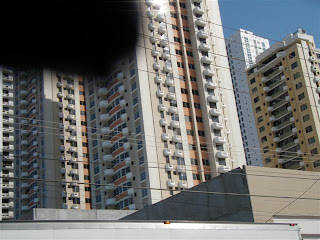
And more on the rise in other parts of the city.

The city itself has a population of 1 million (all of Panama is 3 million). At one traffic light, I counted nine tower cranes and would guess that the whole city contained twenty to thirty cranes.
Panama City has also felt the financial crunch and condo sales are down, but building activity has been spurred by the flight of the rich from unstable political areas in Central and South America. Second only to Miami, Panama is a good refuge for rich Central and South American families seeking security and stability.
Another growth impetus in Panama is its low labor cost - typical labor is only $2.00/hour.
Roger and I visited the Panama Canal and were impressed with its scale and the quality of the museum. There are only 3 lock systems, but each has two lanes.


Fourteen kilometers of the canal is through a central lake, pictured above. It takes eight hours for a ship to traverse the canal. The cost per trip for the largest ships is $240,000. They are widening the canal and building two new lock systems which will enable a ship with twice the payload to traverse the canal. The current limit is a ship carrying 4,000 containers – the new locks will accommodate ships carrying 10,000 containers.
The GDP purchasing power parity (PPP) here is approximately $1,600 versus Mexico’s approximately $5,000. With the wealth evident in Panama City, this implies a large disparity in distribution across the population.
We spent the rest of the day as a group at the airport assisting with the crating of our bikes for the flight to Bogota, Colombia. The pallets were made from scrap pallets and lumber…
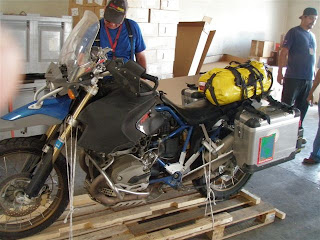
And scrap cardboard…
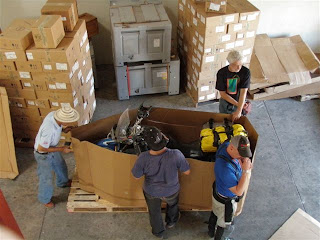
And then the whole thing was wrapped in clingy plastic.
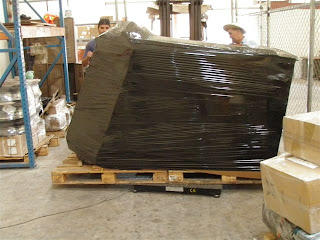
The process lasted until nearly 8:00 that night.
The crating process was tedious and expensive (over $1,000 per bike) – but it beats two weeks worth of sea travel which would probably end up costing about the same. Helge has determined a better way to handle this for the group traveling next year.
We caught our flight to Bogota:

The next day we met Luis Mojicas at the airport. Luis had not previously met Helge, but he is a motorcycle fanatic with whom Helge has frequently corresponded. We had dinner that evening with Luis at his house with his lovely wife, Anabella, and got their perspective on Bogota and Colombia.
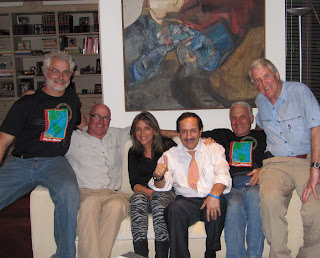
They introduced us to some of their friends, and we talked at length about Colombia. Luis is a fundraiser for UNICEF and is currently extremely busy raising funds for the Haiti relief – we were grateful that he was able to spend time with us.
Bogota is a city of contrasts. With a population of 7 million, it is the size of Chicago with beautiful neighborhoods encompassing about 20% of the city. We went to a shopping center near their house – it had all the fancy stores and was spotlessly clean and organized. But the specter of danger lingered there, despite the glittering of the storefronts. Security was prevalent– just outside of the shopping center, Vincent was taking pictures and was asked to stop by the security guard.
Luis and Anabella’s friends were animated and very western in their thinking and mannerisms. While we were waiting for the motorcycles to arrive, we went on a tour of Bogota. There was a rather stark city square (unlike the warm inviting city squares we experienced in Central America) surrounded by city and federal government buildings.
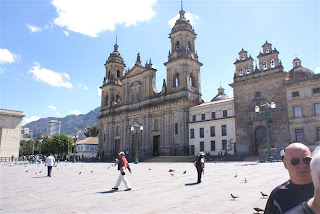

We took a dizzying cable car ride to the top of a shrine which overlooks Bogota:
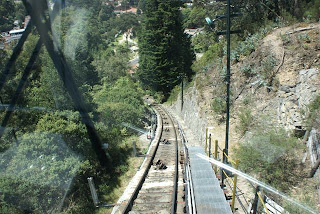
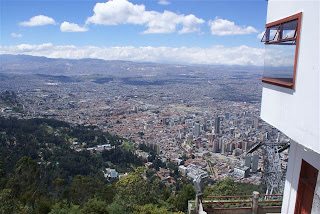
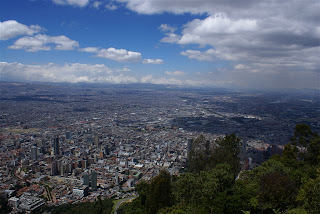
The shrine was crowded with families:

We met a nun who was part of a group of nuns from scattered locations including South America and Africa. They were attempting to develop a strategy to reach today’s youth. During this trip, we heard the good news and the bad news about the Catholic Church in Central America – the good news is that nearly 90% of the people consider themselves Catholic – the bad news is that despite such a large “market share,” the church has not been particularly effective at modifying behavior. The nun, who was extremely articulate and intelligent, explained the difficulty of fighting the culture, particularly with the prevalence of television and youth’s tendency to emulate the behavior they see on TV.

She made the case that as nuns they try to lead by example. But it’s difficult to compete with the fairly seedy television we have seen on this trip—in an extreme way, its programming promotes the valuing of appearance over substance and is significantly more sexualized than the programming in the US. The programming is aimed at a younger age level, which makes sense as 30% of the population is under age 15 versus 20% in the US. Also, 7.5% of the population is over age 60 versus 17% in the US. Television is way too strong of an influence even for an institution as powerful as the Catholic Church. It was refreshing to talk to such an intelligent lady who was focused on this problem and was, along with her associates, trying to do all she could to help. But it doesn’t look as though the Catholic Church will be able to be successful in significantly decreasing the crime and birth rates here.
In Mexico and Colombia – the two large industrial nations we have visited – the GDP (economic activity) is growing faster than the population and this is a stabilizing factor. However, in Central American countries such as Nicaraugua and Honduras, there could be a situation emerging where there is a declining per capital GDP, which is a prescription for instability.
Later that day, we picked up our bikes from the airport and had two young men lead us on their bike to the local BMW shop. On their small bike, they were weaving in and out of traffic and it was difficult to keep up with him – until his bike got a flat tire. Helge took his passenger and we found our way to the dealership.
The dealership had consented to work on Sunday morning on our bikes – all four of them needed the 10,000 mile inspection and a new set of knobby tires which are better in the mud. Vincent’s bike also needed a new front skid plate, and I needed new front brake pads installed and to have the front end of the bike lowered another ¼ inch.
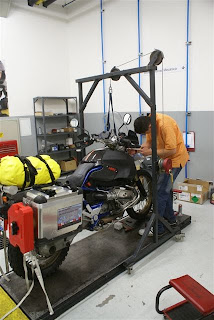
We ran into a classic Colombian situation – credit card companies look very hard at transactions in Colombia, and even though we had called the credit card companies to explain the situation prior to our trip, they were unwilling to process the BMW bill (that’s why you carry lots of credit cards).
That night we ate at Andres Carne, the most remarkable restaurant I believe I’ve ever seen, about ten kilometers outside Bogota in the town of Chia. The restaurant was huge, seating about 2,000 people (with another 1,000 standing), and was designed by a hippie artist thirty years ago. All sorts of art, junk, and mechanical contrivances – just about everything you can imagine – was hanging from the walls and ceiling.

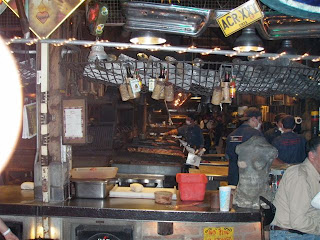

Bands would parade through the restaurant making a racket and creating excitement.
There was nonstop cheering and singing in Spanish. We encountered some clowns…
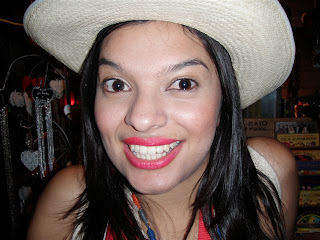
And a dog – carrying yet another birthday cake for me (how many times will I have to celebrate this year?).
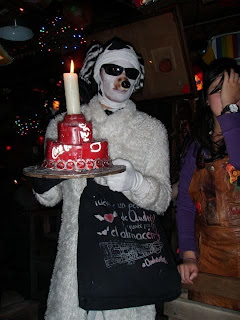
Here we are with the harassed bar owner (not exactly the lifestyle strived for by a hippie)

The restaurant was an installation work, staffed by 700 college students and musicians, who would come romping through the restaurant, raising a ruckus.
Knowing we had to make an early start in the morning, we left around 10:00 p.m. – 2 hours before the real craziness begins. The restaurant closes at 5:00 a.m., and apparently great care is taken so that no one drives home intoxicated. The energy of the place was enormous. The service was just okay, but the experience was extraordinary. I believe this concept would work in the US if someone had the patience to pull it off.
After five days without significant riding, it was fun to get on the road again. We headed out in the morning, led by Luis and Anabella:

The numbers displayed on the front and back of their jackets and helmets are the license numbers of the motorcycles. This garb is required in many places in Central and South America because assassins use motorcycles to cut through traffic and crowds while carrying a passenger with a rifle or pistol. They use the speed and maneuverability of the bike to eliminate government officials, judges, or others whose interests don’t align with their own.
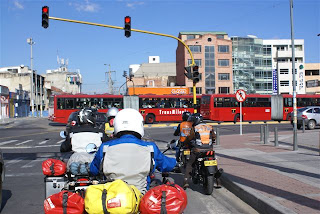
We started up into the mountains, stopping at a café along the way:
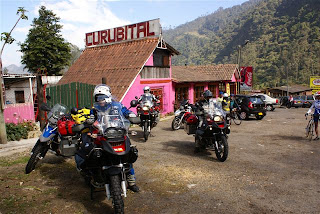
Bicycling is hugely popular in Colombia, and this small country of 45 million has won a number of international events. There were thousands of bicyclists dressed in fancy racing gear with bikes so fancy that they brought them into the restaurant to keep them safe from theft.

We began in Bogota at 7,000 feet and drove to a windy and cool peak altitude of 10,500 feet (the highest point in Colombia), riding through a series of sharp switchbacks and down into valleys as low as 1,000 feet where the temperature was 100°F.
Roger was stopped by police twice for speeding (no one else was stopped). Soldiers have helped to keep this road open and are very supportive. There are significant checkpoints along the way and we had a chance to stop and speak with the soldiers. The FARC guerillas here have been planting mines to protect their territory, resulting in the Colombian army having the second highest casualty rate in the world for mine-inflicted injuries. As we drive by, they gave us a “thumbs-up” to indicate the area is clear.
We arrived at a resort area west of Bogota near Quindio.
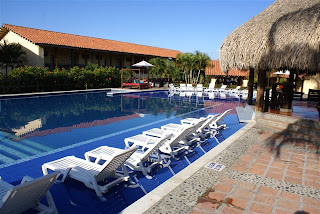
I had a twinge of anxiety when I saw a horse and pony corralled in the lobby (fearing we may be in for some sort of Tijuana experience), but it turned out to be a resort for families and had clowns and ponies for the children.

We couldn’t stay in a “normal” room, because we would have been too far from our bikes – Helge always insists we keep them nearby (a cowboy must sleep near his horse) – so they put all six of us in a condo with its own pool…

Which was perched on the edge of the rainforest.

February 1
The day started well – I was awarded “camper of the day” for the previous day – but only by default. Roger’s two speeding tickets knocked him out of the running, and Vince committed the cardinal error of checking out and leaving behind his computer and an essential piece of luggage in his room.
The only item left in Vincent’s panniers was a pair of dirty underwear:
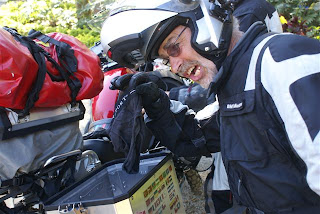
Luckily, a hotel clerk checking the room to ensure that we hadn’t caused any damage or stolen any towels came across Vince’s belongings and informed him prior to our leaving the hotel. (The fact that the hotel would check our rooms before we left shows just how grungy we all look).
I showed Anabella the pictures of my family posted on my pannier. She approves whole-heartedly of the 5 grandchildren and 6 dogs (she agrees that it is appropriate to have more dogs than grandchildren).

We packed our bikes, had breakfast, and headed back to a spot just off the Pan American Highway to a spot where we would say goodbye to Luis and Anabella.
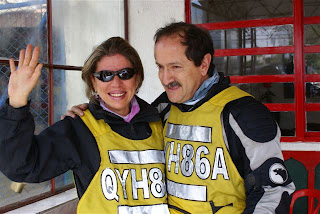
They have been magnificent hosts – we met their friends and were provided with a wonderful flavor of Colombian culture. They cleared up many misconceptions we had about Colombia. We are hoping that they will come to the US in June and join us for some riding in the States.

We rode along the Pan American Highway, which stretches from Alaska to Buenos Aires with only an 80-mile break in the Darien Gap between Panama and Colombia. Colombia would like to fill this gap, but Panama has concerns – one is the spread of hoof in mouth disease. According to some, the Darien Gap has the greatest plant and small animal diversity than any other spot on the planet.
Along the way and throughout the coffee-growing regions of Colombia there are 50’s and 60’s era jeeps “Old Willy’s” everywhere – clearly a cult item:

They are this region’s version of the Harley Davidson motorcycle:
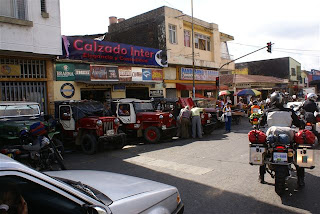
We continued south to Pasto, covering 360 miles, and experienced some of Colombia’s diversity. We have heard it said that Colombia’s violence and crime can be blamed in part on its being a melting pot. Colombia is 50% Mestizo – a mix of Indian and European (Luis and Anabella fall into this category). The next largest racial group is white, approximately 20%. There is a small Black African population, perhaps 4%, along the coast and near Cali where sugar cane is processed, and Mulattos make up another 14% of the population.
One of many sugar cane plants we saw:
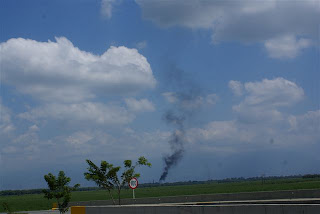
Tractors and over-the-road haul trucks – pulling as many as five 40 foot trailers to the plant for processing:


Helge decided to bypass Cali – improperly known for its narcotic involvement, but more properly known for its beautiful women. According to most experts, its women rank third in beauty in the world; ranked second (according to National Geographic) is Novosibirsk, Siberia; and of course the most beautiful women in the world are in Cleveland. According to what we heard, Cali is the center for silicone enhancements. Colombia’s drug mafia favor enhanced derrières first and breast enhancements second. The drug group used to be prominent in Cali with their fancy cars and arrogance, all hunched over from the weight of their gold chains and bracelets. They generally had a large number of silicone-enhanced women in tow – but tough enforcement has driven these people underground and they now tend to live out in the country.
From the all-too-brief visit of Colombia, we were all dazzled by the country and the warm hospitality of the people – their friendliness, enthusiasm and love of their country. Colombia’s current tourist tag-line is something like “the only risk in Colombia is that you won’t want to leave.” It’s fitting but suggests a perceived risk to tourists. These risks come in three categories – one is the mafia, as the locals call them (who engage in drug processing in mini factories in the forests and then smuggle cocaine through Mexico and in other ways into the US market). These people are not a risk to tourists, but rather they are a risk to Colombian and US national security: they fund political campaigns, they undermine political systems through the vast amount of profit provided by the illegal drug market to the aggressive, lawless and unscrupulous middle man. They create their own morality, just like the runners did in the US during prohibition. The US government and the Colombian government have placed a huge priority on stopping (or slowing down) the Colombian drug industry and distribution. But the real problem is the demand and profit opportunity from the US. I increasingly feel that a solution (although I am not well-informed) would be to legalize drugs in the US, make them available by prescription and tattoo the users defining them as such. This would eliminate the profit opportunity and in so doing would reduce the number of people addicted each year. This is obviously a complicated subject – but the drug problems I see in Colombia and Central America seem to be US problems – not Central and South American problems.
The second perceived crime risk in Colombia is a more significant one – petty theft and robbery. These problems can be invited in a couple of ways – the first is not keeping track of your possessions (parking your motorcycles unattended) – this is preventable. The second category is taxi cabs. A classic robbery approach is having the cab take you to a place where people jump into the cab and rob you – sometimes taking you to an automated teller to obtain more cash. This too is preventable: get a cab at the hotel and keep the same cab while shopping. If you need to call a cab, you can obtain a code to confirm you have a legitimate cab.
The third risk is a problem mainly for Colombians – where they are kidnapped and held for ransom or worse. This weighs on the minds of all Colombians, and it’s why there are tall walls and fences everywhere.
Passing by Cali, the drive was incredibly beautiful – climbing up through the mountains to nearly 9,000 feet – viewing the valley thousands of feet straight down. The road was cut into the side of the mountain, creating overhangs in some spots. Unlike the range we had crossed earlier in the day, it was dry and rocky with a minimum of vegetation. We could see the entire view of the mountain range – two and three deep – roughly 30 degrees off vertical.
As we neared Pasto upon reaching the top of a hill, we saw nearly thirty Indians begging alongside the road. Given the terrain, it would have been impossible to stop even if you wanted to give them something—the futility of their begging there was puzzling and tragic. The Indian population is by far the most impoverished and makes up only 2% of the population. As we travel farther south, the Indian population will become much more significant.
We arrived in Pasto in heavy traffic after a 360-mile ride:
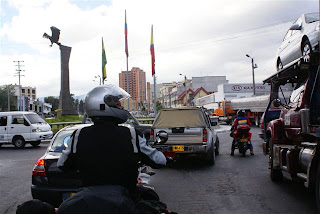
We got a hotel behind locked gates with our bikes twenty feet away from a 24-hour security guard. But having said all of this about security, the joy of being in Colombia far outweighs any risk to security. There are simple ways to keep safe, and the country is well worth the trip.

Tomorrow, we will cross the border into Ecuador and head to Quito (crossing the equator). Our plan is to stay two or three days in Ecuador before moving on.
With large numbers of high rise apartments…
And more on the rise in other parts of the city.
The city itself has a population of 1 million (all of Panama is 3 million). At one traffic light, I counted nine tower cranes and would guess that the whole city contained twenty to thirty cranes.
Panama City has also felt the financial crunch and condo sales are down, but building activity has been spurred by the flight of the rich from unstable political areas in Central and South America. Second only to Miami, Panama is a good refuge for rich Central and South American families seeking security and stability.
Another growth impetus in Panama is its low labor cost - typical labor is only $2.00/hour.
Roger and I visited the Panama Canal and were impressed with its scale and the quality of the museum. There are only 3 lock systems, but each has two lanes.
Fourteen kilometers of the canal is through a central lake, pictured above. It takes eight hours for a ship to traverse the canal. The cost per trip for the largest ships is $240,000. They are widening the canal and building two new lock systems which will enable a ship with twice the payload to traverse the canal. The current limit is a ship carrying 4,000 containers – the new locks will accommodate ships carrying 10,000 containers.
The GDP purchasing power parity (PPP) here is approximately $1,600 versus Mexico’s approximately $5,000. With the wealth evident in Panama City, this implies a large disparity in distribution across the population.
We spent the rest of the day as a group at the airport assisting with the crating of our bikes for the flight to Bogota, Colombia. The pallets were made from scrap pallets and lumber…
And scrap cardboard…
And then the whole thing was wrapped in clingy plastic.
The process lasted until nearly 8:00 that night.
The crating process was tedious and expensive (over $1,000 per bike) – but it beats two weeks worth of sea travel which would probably end up costing about the same. Helge has determined a better way to handle this for the group traveling next year.
We caught our flight to Bogota:

The next day we met Luis Mojicas at the airport. Luis had not previously met Helge, but he is a motorcycle fanatic with whom Helge has frequently corresponded. We had dinner that evening with Luis at his house with his lovely wife, Anabella, and got their perspective on Bogota and Colombia.
They introduced us to some of their friends, and we talked at length about Colombia. Luis is a fundraiser for UNICEF and is currently extremely busy raising funds for the Haiti relief – we were grateful that he was able to spend time with us.
Bogota is a city of contrasts. With a population of 7 million, it is the size of Chicago with beautiful neighborhoods encompassing about 20% of the city. We went to a shopping center near their house – it had all the fancy stores and was spotlessly clean and organized. But the specter of danger lingered there, despite the glittering of the storefronts. Security was prevalent– just outside of the shopping center, Vincent was taking pictures and was asked to stop by the security guard.
Luis and Anabella’s friends were animated and very western in their thinking and mannerisms. While we were waiting for the motorcycles to arrive, we went on a tour of Bogota. There was a rather stark city square (unlike the warm inviting city squares we experienced in Central America) surrounded by city and federal government buildings.
We took a dizzying cable car ride to the top of a shrine which overlooks Bogota:
The shrine was crowded with families:
We met a nun who was part of a group of nuns from scattered locations including South America and Africa. They were attempting to develop a strategy to reach today’s youth. During this trip, we heard the good news and the bad news about the Catholic Church in Central America – the good news is that nearly 90% of the people consider themselves Catholic – the bad news is that despite such a large “market share,” the church has not been particularly effective at modifying behavior. The nun, who was extremely articulate and intelligent, explained the difficulty of fighting the culture, particularly with the prevalence of television and youth’s tendency to emulate the behavior they see on TV.
She made the case that as nuns they try to lead by example. But it’s difficult to compete with the fairly seedy television we have seen on this trip—in an extreme way, its programming promotes the valuing of appearance over substance and is significantly more sexualized than the programming in the US. The programming is aimed at a younger age level, which makes sense as 30% of the population is under age 15 versus 20% in the US. Also, 7.5% of the population is over age 60 versus 17% in the US. Television is way too strong of an influence even for an institution as powerful as the Catholic Church. It was refreshing to talk to such an intelligent lady who was focused on this problem and was, along with her associates, trying to do all she could to help. But it doesn’t look as though the Catholic Church will be able to be successful in significantly decreasing the crime and birth rates here.
In Mexico and Colombia – the two large industrial nations we have visited – the GDP (economic activity) is growing faster than the population and this is a stabilizing factor. However, in Central American countries such as Nicaraugua and Honduras, there could be a situation emerging where there is a declining per capital GDP, which is a prescription for instability.
Later that day, we picked up our bikes from the airport and had two young men lead us on their bike to the local BMW shop. On their small bike, they were weaving in and out of traffic and it was difficult to keep up with him – until his bike got a flat tire. Helge took his passenger and we found our way to the dealership.
The dealership had consented to work on Sunday morning on our bikes – all four of them needed the 10,000 mile inspection and a new set of knobby tires which are better in the mud. Vincent’s bike also needed a new front skid plate, and I needed new front brake pads installed and to have the front end of the bike lowered another ¼ inch.
We ran into a classic Colombian situation – credit card companies look very hard at transactions in Colombia, and even though we had called the credit card companies to explain the situation prior to our trip, they were unwilling to process the BMW bill (that’s why you carry lots of credit cards).
That night we ate at Andres Carne, the most remarkable restaurant I believe I’ve ever seen, about ten kilometers outside Bogota in the town of Chia. The restaurant was huge, seating about 2,000 people (with another 1,000 standing), and was designed by a hippie artist thirty years ago. All sorts of art, junk, and mechanical contrivances – just about everything you can imagine – was hanging from the walls and ceiling.
Bands would parade through the restaurant making a racket and creating excitement.
There was nonstop cheering and singing in Spanish. We encountered some clowns…
And a dog – carrying yet another birthday cake for me (how many times will I have to celebrate this year?).
Here we are with the harassed bar owner (not exactly the lifestyle strived for by a hippie)
The restaurant was an installation work, staffed by 700 college students and musicians, who would come romping through the restaurant, raising a ruckus.
Knowing we had to make an early start in the morning, we left around 10:00 p.m. – 2 hours before the real craziness begins. The restaurant closes at 5:00 a.m., and apparently great care is taken so that no one drives home intoxicated. The energy of the place was enormous. The service was just okay, but the experience was extraordinary. I believe this concept would work in the US if someone had the patience to pull it off.
After five days without significant riding, it was fun to get on the road again. We headed out in the morning, led by Luis and Anabella:
The numbers displayed on the front and back of their jackets and helmets are the license numbers of the motorcycles. This garb is required in many places in Central and South America because assassins use motorcycles to cut through traffic and crowds while carrying a passenger with a rifle or pistol. They use the speed and maneuverability of the bike to eliminate government officials, judges, or others whose interests don’t align with their own.
We started up into the mountains, stopping at a café along the way:
Bicycling is hugely popular in Colombia, and this small country of 45 million has won a number of international events. There were thousands of bicyclists dressed in fancy racing gear with bikes so fancy that they brought them into the restaurant to keep them safe from theft.
We began in Bogota at 7,000 feet and drove to a windy and cool peak altitude of 10,500 feet (the highest point in Colombia), riding through a series of sharp switchbacks and down into valleys as low as 1,000 feet where the temperature was 100°F.
Roger was stopped by police twice for speeding (no one else was stopped). Soldiers have helped to keep this road open and are very supportive. There are significant checkpoints along the way and we had a chance to stop and speak with the soldiers. The FARC guerillas here have been planting mines to protect their territory, resulting in the Colombian army having the second highest casualty rate in the world for mine-inflicted injuries. As we drive by, they gave us a “thumbs-up” to indicate the area is clear.
We arrived at a resort area west of Bogota near Quindio.
I had a twinge of anxiety when I saw a horse and pony corralled in the lobby (fearing we may be in for some sort of Tijuana experience), but it turned out to be a resort for families and had clowns and ponies for the children.
We couldn’t stay in a “normal” room, because we would have been too far from our bikes – Helge always insists we keep them nearby (a cowboy must sleep near his horse) – so they put all six of us in a condo with its own pool…
Which was perched on the edge of the rainforest.
February 1
The day started well – I was awarded “camper of the day” for the previous day – but only by default. Roger’s two speeding tickets knocked him out of the running, and Vince committed the cardinal error of checking out and leaving behind his computer and an essential piece of luggage in his room.
The only item left in Vincent’s panniers was a pair of dirty underwear:
Luckily, a hotel clerk checking the room to ensure that we hadn’t caused any damage or stolen any towels came across Vince’s belongings and informed him prior to our leaving the hotel. (The fact that the hotel would check our rooms before we left shows just how grungy we all look).
I showed Anabella the pictures of my family posted on my pannier. She approves whole-heartedly of the 5 grandchildren and 6 dogs (she agrees that it is appropriate to have more dogs than grandchildren).
We packed our bikes, had breakfast, and headed back to a spot just off the Pan American Highway to a spot where we would say goodbye to Luis and Anabella.
They have been magnificent hosts – we met their friends and were provided with a wonderful flavor of Colombian culture. They cleared up many misconceptions we had about Colombia. We are hoping that they will come to the US in June and join us for some riding in the States.
We rode along the Pan American Highway, which stretches from Alaska to Buenos Aires with only an 80-mile break in the Darien Gap between Panama and Colombia. Colombia would like to fill this gap, but Panama has concerns – one is the spread of hoof in mouth disease. According to some, the Darien Gap has the greatest plant and small animal diversity than any other spot on the planet.
Along the way and throughout the coffee-growing regions of Colombia there are 50’s and 60’s era jeeps “Old Willy’s” everywhere – clearly a cult item:
They are this region’s version of the Harley Davidson motorcycle:
We continued south to Pasto, covering 360 miles, and experienced some of Colombia’s diversity. We have heard it said that Colombia’s violence and crime can be blamed in part on its being a melting pot. Colombia is 50% Mestizo – a mix of Indian and European (Luis and Anabella fall into this category). The next largest racial group is white, approximately 20%. There is a small Black African population, perhaps 4%, along the coast and near Cali where sugar cane is processed, and Mulattos make up another 14% of the population.
One of many sugar cane plants we saw:
Tractors and over-the-road haul trucks – pulling as many as five 40 foot trailers to the plant for processing:
Helge decided to bypass Cali – improperly known for its narcotic involvement, but more properly known for its beautiful women. According to most experts, its women rank third in beauty in the world; ranked second (according to National Geographic) is Novosibirsk, Siberia; and of course the most beautiful women in the world are in Cleveland. According to what we heard, Cali is the center for silicone enhancements. Colombia’s drug mafia favor enhanced derrières first and breast enhancements second. The drug group used to be prominent in Cali with their fancy cars and arrogance, all hunched over from the weight of their gold chains and bracelets. They generally had a large number of silicone-enhanced women in tow – but tough enforcement has driven these people underground and they now tend to live out in the country.
From the all-too-brief visit of Colombia, we were all dazzled by the country and the warm hospitality of the people – their friendliness, enthusiasm and love of their country. Colombia’s current tourist tag-line is something like “the only risk in Colombia is that you won’t want to leave.” It’s fitting but suggests a perceived risk to tourists. These risks come in three categories – one is the mafia, as the locals call them (who engage in drug processing in mini factories in the forests and then smuggle cocaine through Mexico and in other ways into the US market). These people are not a risk to tourists, but rather they are a risk to Colombian and US national security: they fund political campaigns, they undermine political systems through the vast amount of profit provided by the illegal drug market to the aggressive, lawless and unscrupulous middle man. They create their own morality, just like the runners did in the US during prohibition. The US government and the Colombian government have placed a huge priority on stopping (or slowing down) the Colombian drug industry and distribution. But the real problem is the demand and profit opportunity from the US. I increasingly feel that a solution (although I am not well-informed) would be to legalize drugs in the US, make them available by prescription and tattoo the users defining them as such. This would eliminate the profit opportunity and in so doing would reduce the number of people addicted each year. This is obviously a complicated subject – but the drug problems I see in Colombia and Central America seem to be US problems – not Central and South American problems.
The second perceived crime risk in Colombia is a more significant one – petty theft and robbery. These problems can be invited in a couple of ways – the first is not keeping track of your possessions (parking your motorcycles unattended) – this is preventable. The second category is taxi cabs. A classic robbery approach is having the cab take you to a place where people jump into the cab and rob you – sometimes taking you to an automated teller to obtain more cash. This too is preventable: get a cab at the hotel and keep the same cab while shopping. If you need to call a cab, you can obtain a code to confirm you have a legitimate cab.
The third risk is a problem mainly for Colombians – where they are kidnapped and held for ransom or worse. This weighs on the minds of all Colombians, and it’s why there are tall walls and fences everywhere.
Passing by Cali, the drive was incredibly beautiful – climbing up through the mountains to nearly 9,000 feet – viewing the valley thousands of feet straight down. The road was cut into the side of the mountain, creating overhangs in some spots. Unlike the range we had crossed earlier in the day, it was dry and rocky with a minimum of vegetation. We could see the entire view of the mountain range – two and three deep – roughly 30 degrees off vertical.
As we neared Pasto upon reaching the top of a hill, we saw nearly thirty Indians begging alongside the road. Given the terrain, it would have been impossible to stop even if you wanted to give them something—the futility of their begging there was puzzling and tragic. The Indian population is by far the most impoverished and makes up only 2% of the population. As we travel farther south, the Indian population will become much more significant.
We arrived in Pasto in heavy traffic after a 360-mile ride:
We got a hotel behind locked gates with our bikes twenty feet away from a 24-hour security guard. But having said all of this about security, the joy of being in Colombia far outweighs any risk to security. There are simple ways to keep safe, and the country is well worth the trip.
Tomorrow, we will cross the border into Ecuador and head to Quito (crossing the equator). Our plan is to stay two or three days in Ecuador before moving on.
Back to Top

Add A Comment